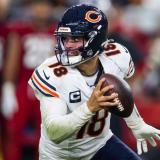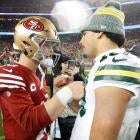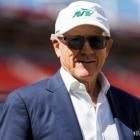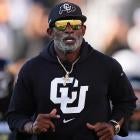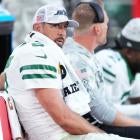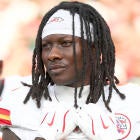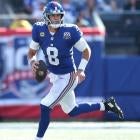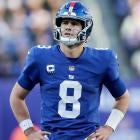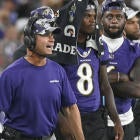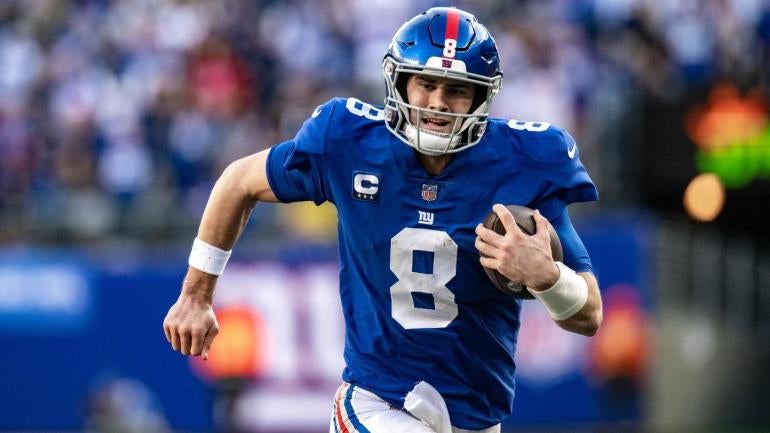
Expectations can be a funny thing. Last year, the Cowboys went 12-5, won a playoff game for the first time since 2018 and had an elite offense that ranked among the top 10 in almost every major category. Their biggest move this offseason was firing offensive coordinator Kellen Moore, who, unsurprisingly, was snapped up by the Chargers within hours. It was generally regarded, fair or not, as another failed season.
The Giants, on the other hand, made the playoffs at 9-7-1 despite a negative playoff differential and won a playoff game before getting blown out by a clearly superior Eagles team. Still, the Giants were ecstatic to keep their coaching staff together and doubled down on their personnel, highlighted by Daniel Jones' $160 million extension. The Giants were hailed as one of the best stories of the season. Brian Daboll won Coach of the Year after his team arrived one year -- at least -- earlier than expected.
The Cowboys, it should be noted, swept the Giants last year and have won 11 of the last 12 meetings overall. Yet it's Dallas that has a big transition to make with Mike McCarthy calling plays. How could the Cowboys offense look different? On the other side, how will a Giants team infused with receiving talent expand in its second year under Daboll, especially against a tough Dallas defense?
When the Giants have the ball
The Giants offense last season -- and I do not mean this as an insult -- had on training wheels. They had the NFL's eighth-highest run rate and its third-highest play-action rate. Only Matt Ryan averaged fewer yards downfield per throw than Jones. It was a Saquon Barkley-centric offense, and that makes sense, because Barkley was far and away the team's best skill-position player. One could argue he was the only one above average, even.
When it wasn't Barkley, it was often Jones, whose athleticism was on full display. He carried the ball 120 times for 708 yards and seven touchdowns. His previous career highs were 65, 423 and two, respectively. This is where the play-action element came into play. The Giants were third in expected points added on quarterback scrambles on passing plays, and first in that category when the scramble came off play action. The only players with more rushing yards off scrambles than Jones last year were Justin Fields and Daboll's former quarterback in Buffalo, Josh Allen. Jones is a legitimately good athlete who developed good timing and awareness for when to use his legs.
Daniel Jones had 708 rushing yards, 7 rushing touchdowns, and averaged 5.9 yards per carry in 2022.
— David Solow (@Giants_Alliance) August 4, 2023
His 84.4 PFF run grade ranked 4th among QBs last season.
Here are Jones' best running plays for the #Giants in 2022: pic.twitter.com/Ez3wJcocB6
In the Giants' first meeting with the Cowboys last season, Jones had seven scrambles for 62 yards. In the second, he had one scramble for 8 yards. Dallas did a better job staying disciplined on play action and not letting Jones break contain: Jones' -0.10 expected points added per play-action snap was his fourth-lowest of any game last year. It also helped mightily that do-it-all safety Jayron Kearse was available after missing the first matchup. Kearse played safety, cornerback and linebacker and often patrolled the middle of the field, a favorite place for Jones to step up and run on non-play actions.
The Giants' solution this offseason was to boost Jones' weapons. The biggest addition was Darren Waller, the former Pro Bowl tight end who is one of just a few players at his position who can be the focal point of a passing offense rather than a complement. If Kearse tries to focus too much on Jones' scrambling, Waller can win in the middle of the field. At his peak powers of 2019 and 2020, Waller's 1,177 yards receiving between the numbers ranked ninth in the NFL and second among tight ends, behind only Travis Kelce.
If there's one area Dallas' defense struggled, it was defending this area of the field. Last season, the Cowboys ranked 28th in completion percentage allowed, and 17th in yards per attempt, on throws between the numbers. If Dallas pays special attention to Jones' scrambling, he now has a new answer. That's exactly what Waller was brought in to be -- the next step up for an offense that showed a promising foundation.
When the Cowboys have the ball
McCarthy's new "Texas Coast" offense is about "70%-ish similar" to the system the Cowboys had under Moore, according to new offensive coordinator Brian Schottenheimer. There's a major adjustment for both parties, though: McCarthy is calling plays for the first time since 2018, and he said he'll be coaching like he's installing a 100% new offense.
McCarthy has implied he wants to run the ball more, but during his time in Green Bay, the Packers ranked 28th in rushing percentage and fifth in passing percentage. His teams dropped back to pass on over 62% of snaps, the second-highest rate in the league. Of course, those teams had Aaron Rodgers. This team has Dak Prescott.
Prescott is coming off a 15-interception season, a career high and tied for most in the NFL last year. Even taking into account some tough luck on dropped passes and other deflections, Prescott's decision-making and inaccuracy were befuddling.
Dak Prescott | ||
2016-21 | 2022 | |
Interception pct | 1.7% (9th out of 51 QBs) | 3.8% (33rd out of 33 QBs) |
Off-target pct | 8.5% | 9.1% |
Last season should be an anomaly more than a trend based on Prescott's past, and McCarthy certainly hopes that's the case.
One area that should help is, simply, the personnel: With no Ezekiel Elliott in the mix, Tony Pollard is the main man in Dallas' backfield. Last season, the Cowboys averaged 5.7 yards per play with him on the field (a number that would have ranked in the top 10 league-wide) compared to 5.0 with him off it (a number that would have ranked 26th, on par with the Jets). When Pollard was on the field, Prescott threw the ball shorter (7.9 air yards per attempt compared to 8.6) and more accurately, got rid of the ball quicker, took fewer sacks and produced fewer mistakes (15-7 TD-INT ratio compared to 8-8).
Pollard taking over the backfield isn't the only major development. The Cowboys also brought in Brandin Cooks via trade to add a much-needed deep threat to the offense. Last season, Prescott completed just 43.2% of his passes 20+ yards downfield, his worst number since 2018, while also posting a career-worst 7.0% interception rate on those throws.
It's hard to know exactly what to expect given a new playcaller, especially because the Cowboys did not play Prescott and many other starters at all in the preseason. The Cowboys have said they want to be more uptempo and more efficient, but they had the third-fastest pace last year in terms of time left on the play clock and ran the eighth-most plays overall. Given the additions and subtractions this offseason, expect a Prescott that throws short more often and is selective with his deep shots, now finally with a legitimate deep threat who the Cowboys hope can help him be more successful in that area, too.





